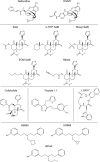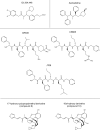Strategies for Developing κ Opioid Receptor Agonists for the Treatment of Pain with Fewer Side Effects
- PMID: 32913006
- PMCID: PMC7589957
- DOI: 10.1124/jpet.120.000134
Strategies for Developing κ Opioid Receptor Agonists for the Treatment of Pain with Fewer Side Effects
Abstract
There is significant need to find effective, nonaddictive pain medications. κ Opioid receptor (KOPr) agonists have been studied for decades but have recently received increased attention because of their analgesic effects and lack of abuse potential. However, a range of side effects have limited the clinical development of these drugs. There are several strategies currently used to develop safer and more effective KOPr agonists. These strategies include identifying G-protein-biased agonists, developing peripherally restricted KOPr agonists without centrally mediated side effects, and developing mixed opioid agonists, which target multiple receptors at specific ratios to balance side-effect profiles and reduce tolerance. Here, we review the latest developments in research related to KOPr agonists for the treatment of pain. SIGNIFICANCE STATEMENT: This review discusses strategies for developing safer κ opioid receptor (KOPr) agonists with therapeutic potential for the treatment of pain. Although one strategy is to modify selective KOPr agonists to create peripherally restricted or G-protein-biased structures, another approach is to combine KOPr agonists with μ, δ, or nociceptin opioid receptor activation to obtain mixed opioid receptor agonists, therefore negating the adverse effects and retaining the therapeutic effect.
Copyright © 2020 by The American Society for Pharmacology and Experimental Therapeutics.
Figures
Similar articles
-
MP1104, a mixed kappa-delta opioid receptor agonist has anti-cocaine properties with reduced side-effects in rats.Neuropharmacology. 2019 May 15;150:217-228. doi: 10.1016/j.neuropharm.2019.02.010. Epub 2019 Feb 13. Neuropharmacology. 2019. PMID: 30768946 Free PMC article.
-
Delta and kappa opioid receptors as suitable drug targets for pain.Clin J Pain. 2010 Jan;26 Suppl 10:S10-5. doi: 10.1097/AJP.0b013e3181c49e3a. Clin J Pain. 2010. PMID: 20026960 Review.
-
Sex differences in kappa opioid pharmacology.Life Sci. 2011 Jan 3;88(1-2):2-16. doi: 10.1016/j.lfs.2010.10.007. Epub 2010 Oct 14. Life Sci. 2011. PMID: 20951148 Free PMC article. Review.
-
Will peripherally restricted kappa-opioid receptor agonists (pKORAs) relieve pain with less opioid adverse effects and abuse potential?J Clin Pharm Ther. 2016 Aug;41(4):371-82. doi: 10.1111/jcpt.12404. Epub 2016 Jun 1. J Clin Pharm Ther. 2016. PMID: 27245498 Review.
-
Biased Opioid Ligands.Molecules. 2020 Sep 16;25(18):4257. doi: 10.3390/molecules25184257. Molecules. 2020. PMID: 32948048 Free PMC article. Review.
Cited by
-
Kappa Opioid Receptor Mediated Differential Regulation of Serotonin and Dopamine Transporters in Mood and Substance Use Disorder.Handb Exp Pharmacol. 2022;271:97-112. doi: 10.1007/164_2021_499. Handb Exp Pharmacol. 2022. PMID: 34136961 Review.
-
Impact of Opioids on Cellular Metabolism: Implications for Metabolic Pathways Involved in Cancer.Pharmaceutics. 2023 Aug 29;15(9):2225. doi: 10.3390/pharmaceutics15092225. Pharmaceutics. 2023. PMID: 37765194 Free PMC article. Review.
-
Peptide Kappa Opioid Receptor Ligands and Their Potential for Drug Development.Handb Exp Pharmacol. 2022;271:197-220. doi: 10.1007/164_2021_519. Handb Exp Pharmacol. 2022. PMID: 34463847 Review.
-
Pharmacology of Kappa Opioid Receptors: Novel Assays and Ligands.Front Pharmacol. 2022 Apr 21;13:873082. doi: 10.3389/fphar.2022.873082. eCollection 2022. Front Pharmacol. 2022. PMID: 35529436 Free PMC article.
-
Design and structural validation of peptide-drug conjugate ligands of the kappa-opioid receptor.Nat Commun. 2023 Dec 6;14(1):8064. doi: 10.1038/s41467-023-43718-w. Nat Commun. 2023. PMID: 38052802 Free PMC article.
References
-
- Abels C, Soeberdt M. (2019) Can we teach old drugs new tricks?-Repurposing of neuropharmacological drugs for inflammatory skin diseases. Exp Dermatol 28:1002–1009. - PubMed
-
- Aldrich JV, Senadheera SN, Ross NC, Reilley KA, Ganno ML, Eans SE, Murray TF, McLaughlin JP. (2014) Alanine analogues of [D-Trp]CJ-15,208: novel opioid activity profiles and prevention of drug- and stress-induced reinstatement of cocaine-seeking behaviour. Br J Pharmacol 171:3212–3222. - PMC - PubMed
-
- Arendt-Nielsen L, Olesen AE, Staahl C, Menzaghi F, Kell S, Wong GY, Drewes AM. (2009) Analgesic efficacy of peripheral kappa-opioid receptor agonist CR665 compared to oxycodone in a multi-modal, multi-tissue experimental human pain model: selective effect on visceral pain. Anesthesiology 111:616–624. - PubMed
Publication types
MeSH terms
Substances
Grants and funding
LinkOut - more resources
Full Text Sources
Medical
Research Materials




